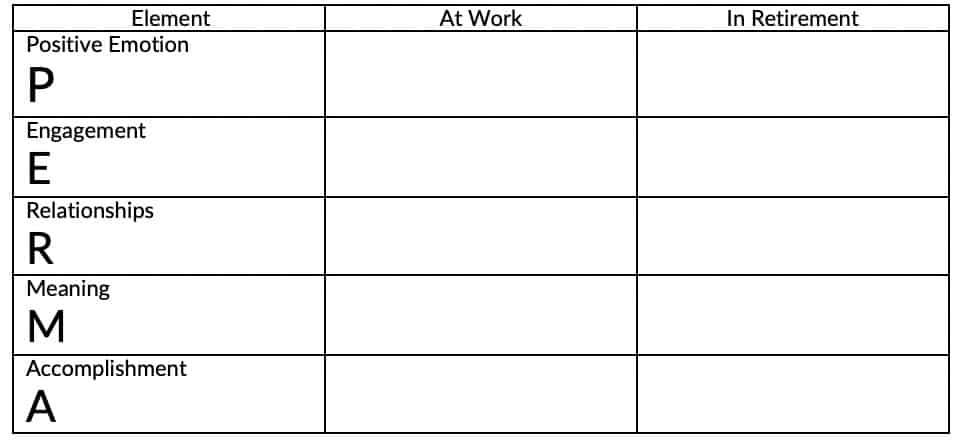In an earlier blog post, we discussed some aspects of nonfinancial retirement planning. If you completed the Retirement Transition Wheel exercise, you may have found there are a few areas of your life that could use some development for a successful retirement. In this post we will look at how using Positive Psychology can also enhance your retirement.
To do this we will look at PERMA, an acronym that that stands for the following five elements: Positive Emotion, Engagement, Relationships, Meaning, Accomplishment. The concept of PERMA was developed by American psychologist Martin Seligman and is a model for sustained happiness and well-being. These elements account for what makes up the “good life.”

Summary and Takeaways
This unique blog details how to utilize the power of the mind and positivity to help ensure a more successful and rewarding retirement lifestyle. The key is an exercise that explores the five elements represented by the acronym PERMA.
Key Takeaways
- PERMA stands for Positive Emotion, Engagement, Relationships, Meaning, and Accomplishment.
- The PERMA concept was developed by psychologist Martin Seligman, and is widely regarded as an excellent guide and model for sustained happiness and well-being.
- This blog explores PERMA in depth, and offers a convenient chart to help visualize the concept and practically implement it in your own life and retirement planning.
- Most people look forward to the freedom of retirement. But your work life and career do provide structure, relationships, and meaningful daily activities.
- In the absence of those retirees often experience a transition that requires replacing those familiar aspects of life with new, intentional ones based on retirement goals.
- The PERMA exercise is a useful tool for gaining awareness of how to create a fulfilling retirement lifestyle, centered on activities that ensure that you flourish in retirement.
The idea of this exercise is to become aware of the need to fill your retirement lifestyle with activities that promote human flourishing. Many people approach retirement having only invested in their careers and in the accumulation of wealth. Now they need to invest in themselves to obtain the most enjoyment possible from the wealth they have built.
Let’s look at each of the PERMA elements:
P – Positive Emotion
Positive emotions such as joy, gratitude, serenity, awe, and love make us feel vibrant and alive. Think about what makes you feel inspired, on top of the world, or unstoppable. At work and then in retirement.
E – Engagement
When we are engaged, our attention is captured, and the everyday boring routines of our lives disappear. Which activities make you feel alive, engaged, or zoned in and like nothing else is going on?
R – Relationships
We all need connection and our own tribe to thrive. Which family members, friends, or colleagues energize you, make you laugh, and provide support?
M – Meaning
A life with meaning requires us to be involved in an activity or a cause that is larger than oneself and which infuses life with a sense of purpose. What gets you out of bed every day and makes you feel compelled to change, improve, or support something?
A – Accomplishment
A sense of accomplishment is important to well-being because goals fortify our lives with structure, and they can provide a sense of identity and satisfaction. What goals, roles, or objectives at work give you the most satisfaction? What things have you been most proud of, and what do you plan to accomplish in retirement?
When it comes to retirement, most people relish the idea of having additional time, less stress, few deadlines, and no more work meetings. Work does provide routine, goals, activities, and relationships, but these can essentially disappear overnight when we stop working. During the “honeymoon” phase, retirees may not notice the absence of what work provided. However, to better prepare for the transition to retirement, consider finding replacements for the things that added value to your life while working.
Below is a table listing the 5 elements of PERMA related to work and retirement. Completing this exercise may make your transition to retirement a positive and stress-free experience.

Read our articles in this series of non-financial retirement planning: